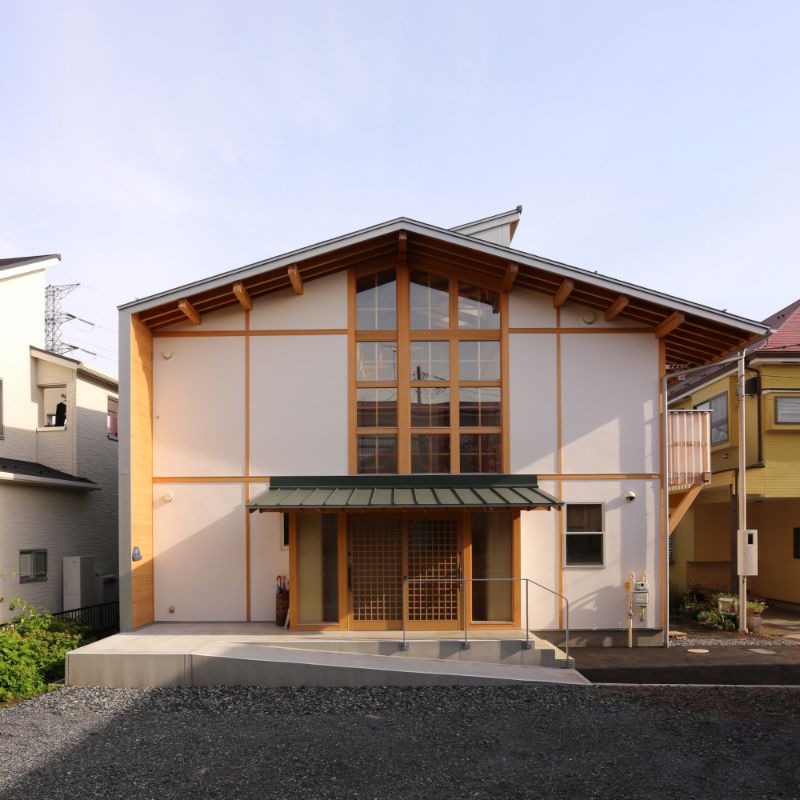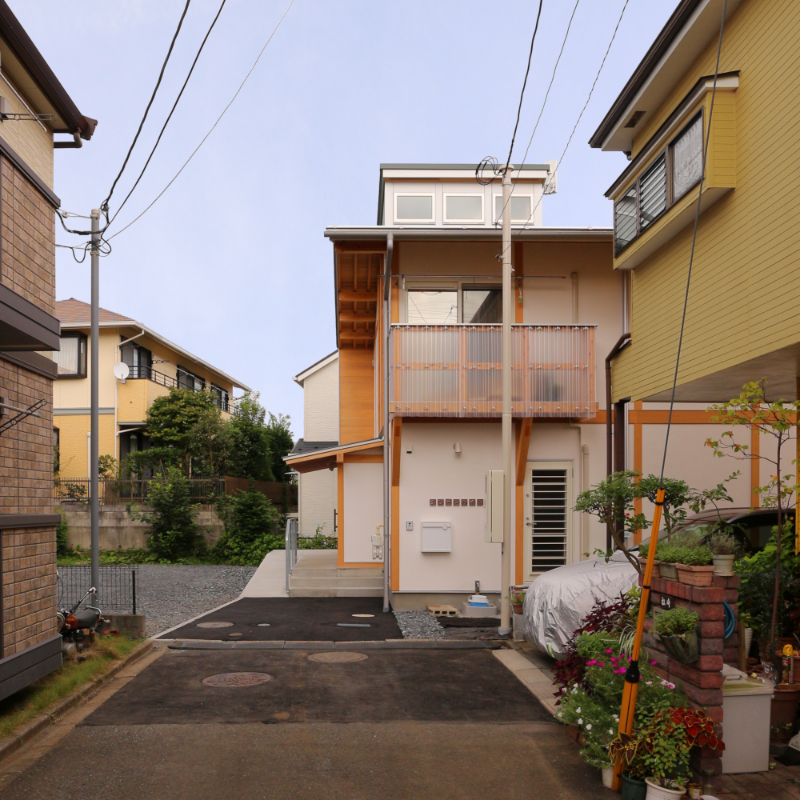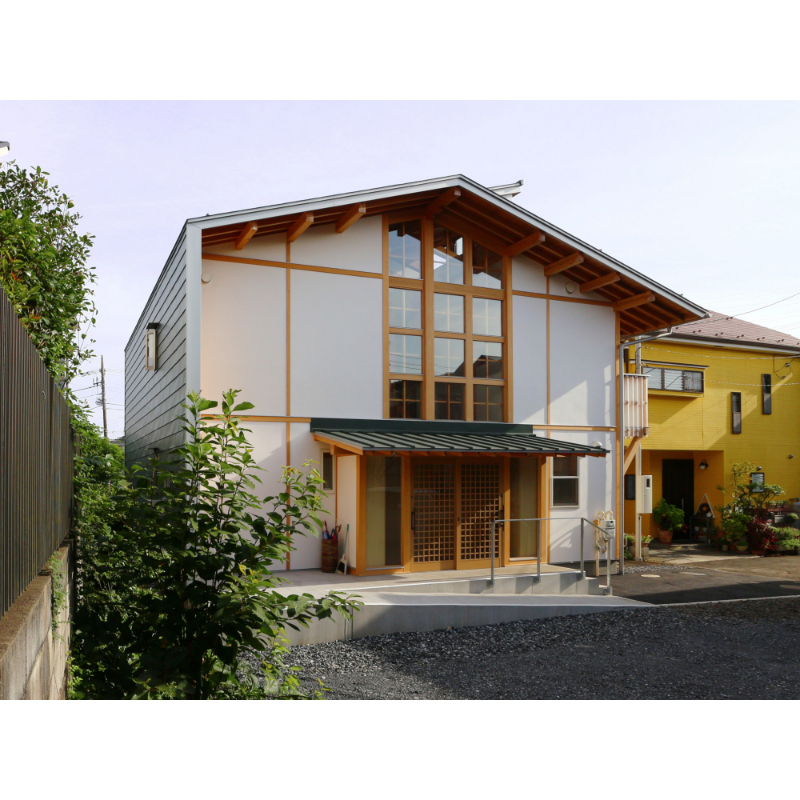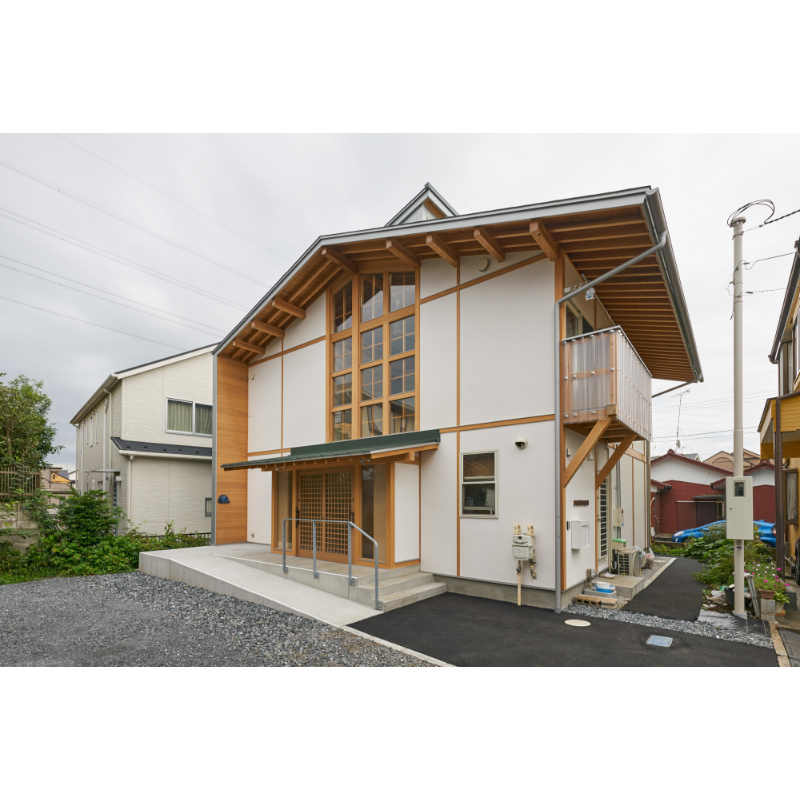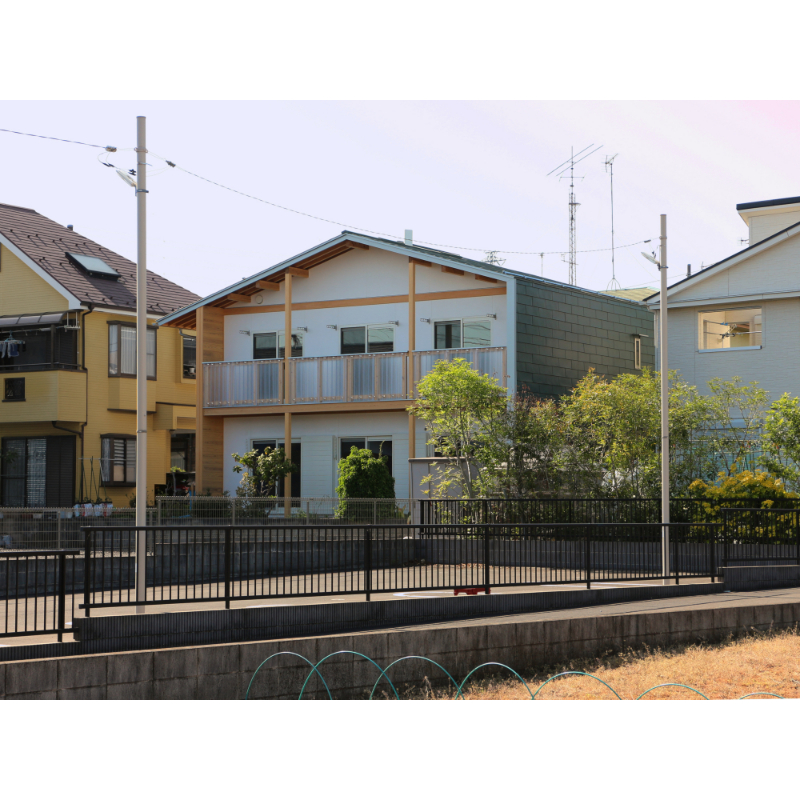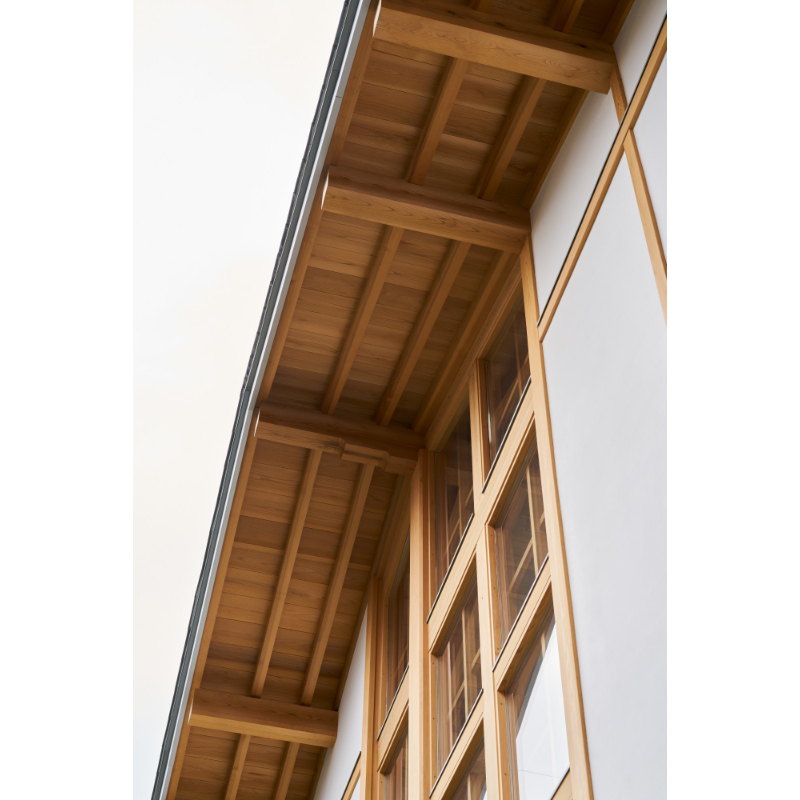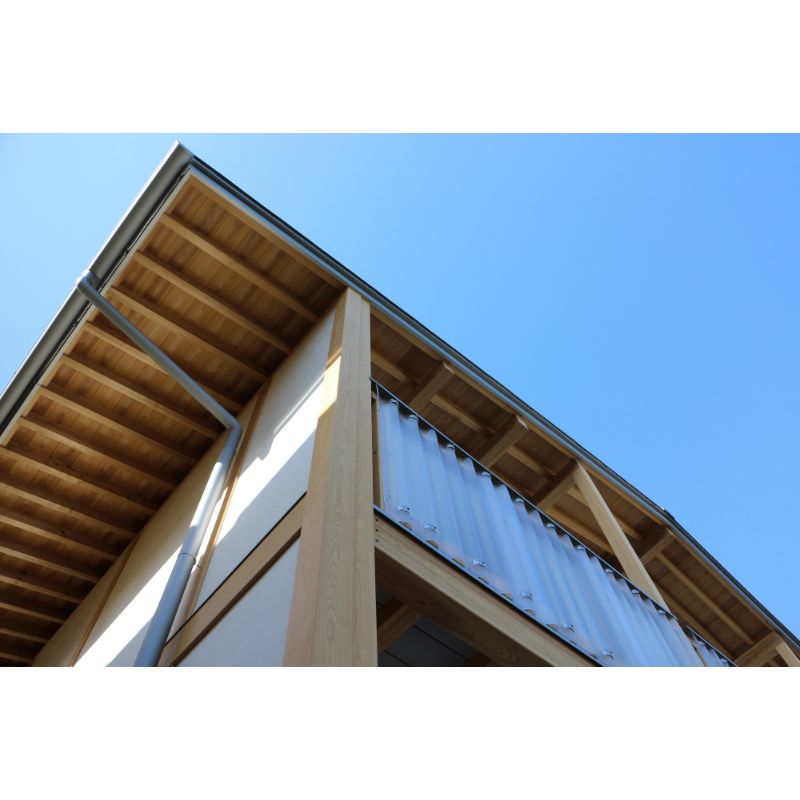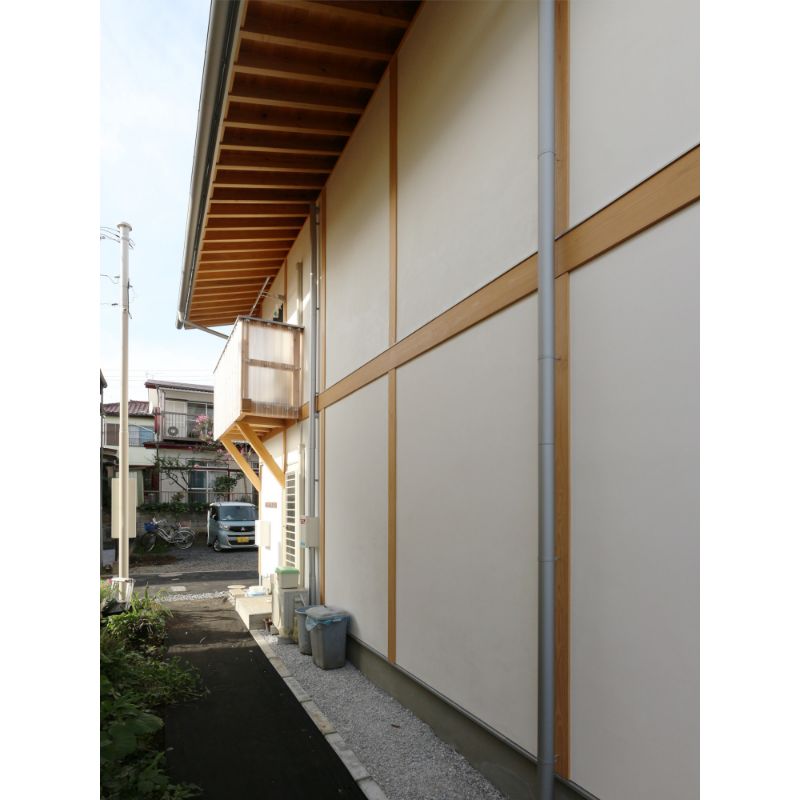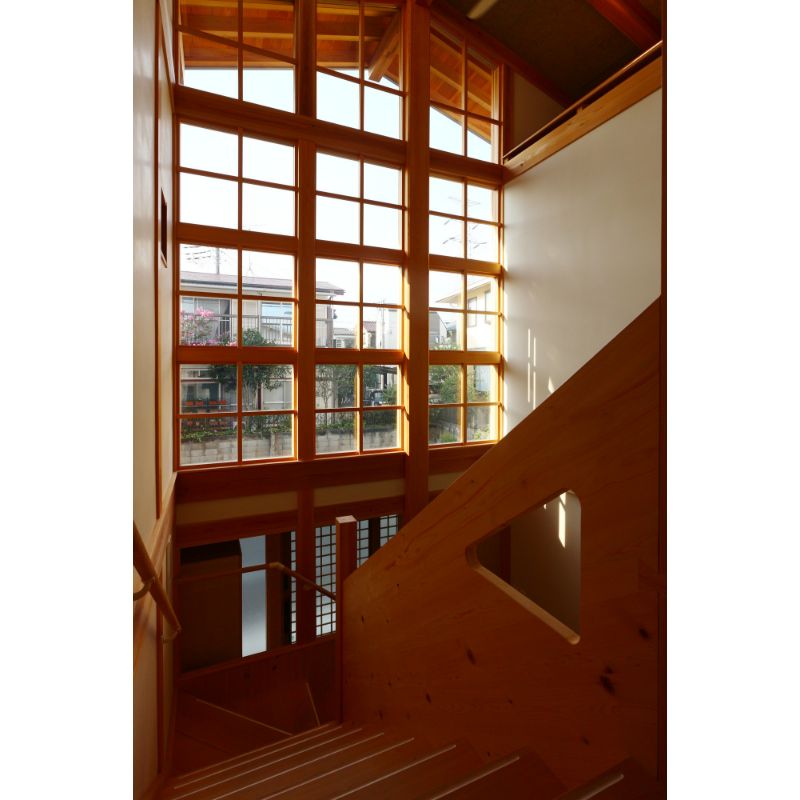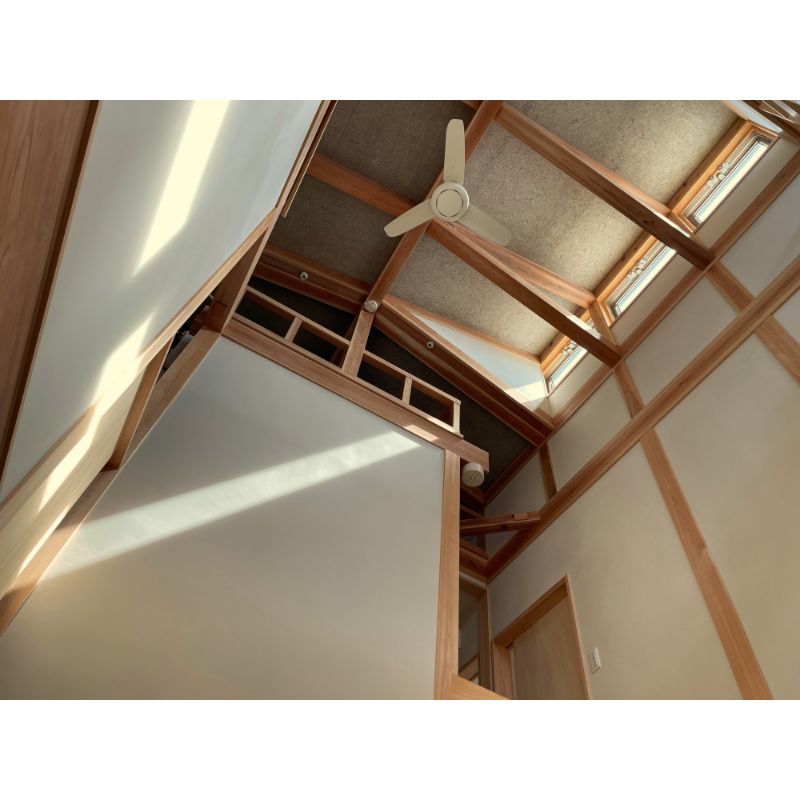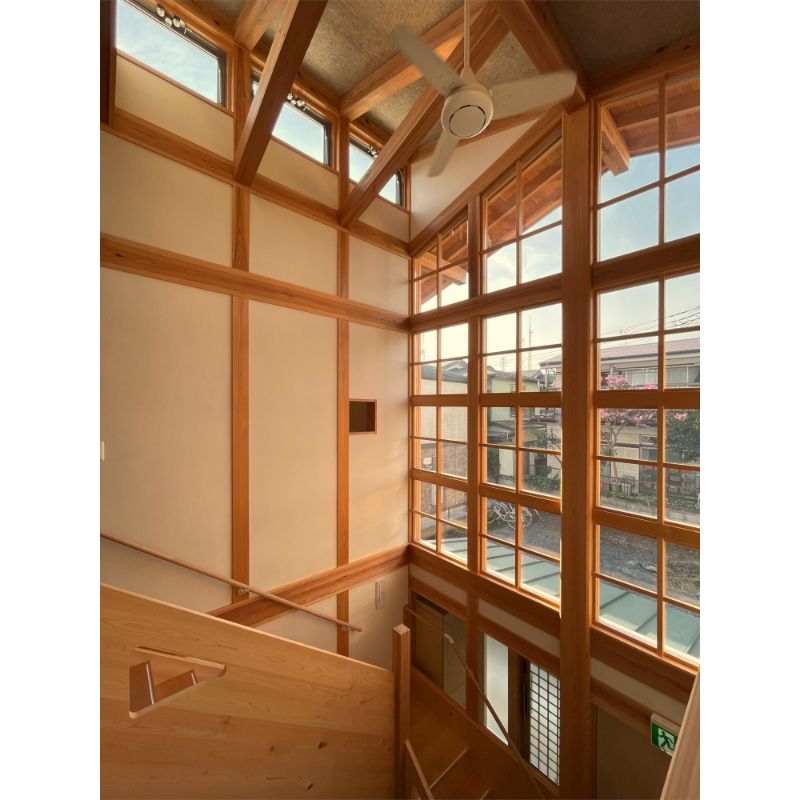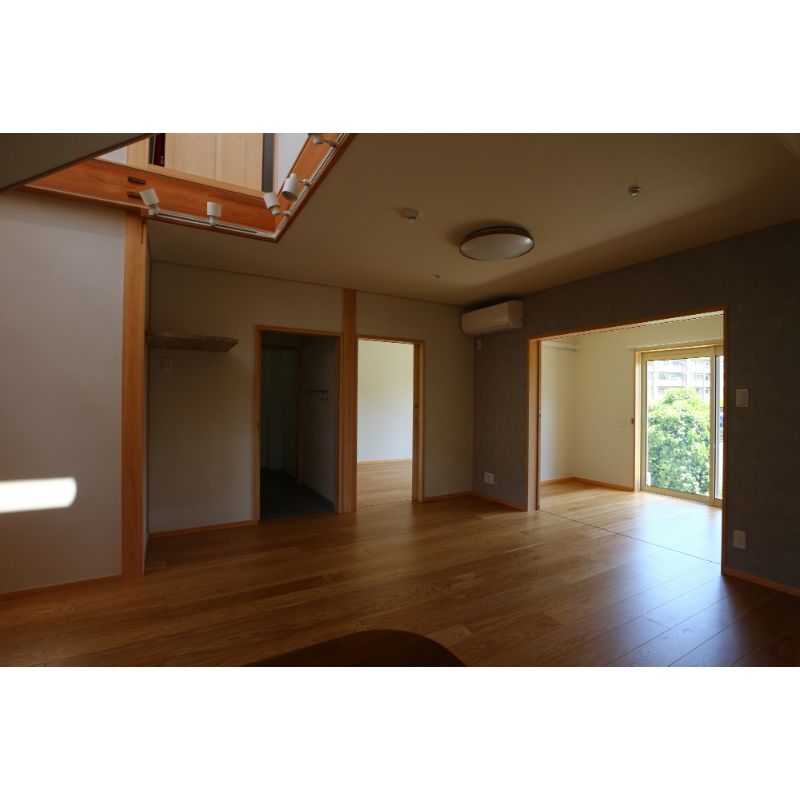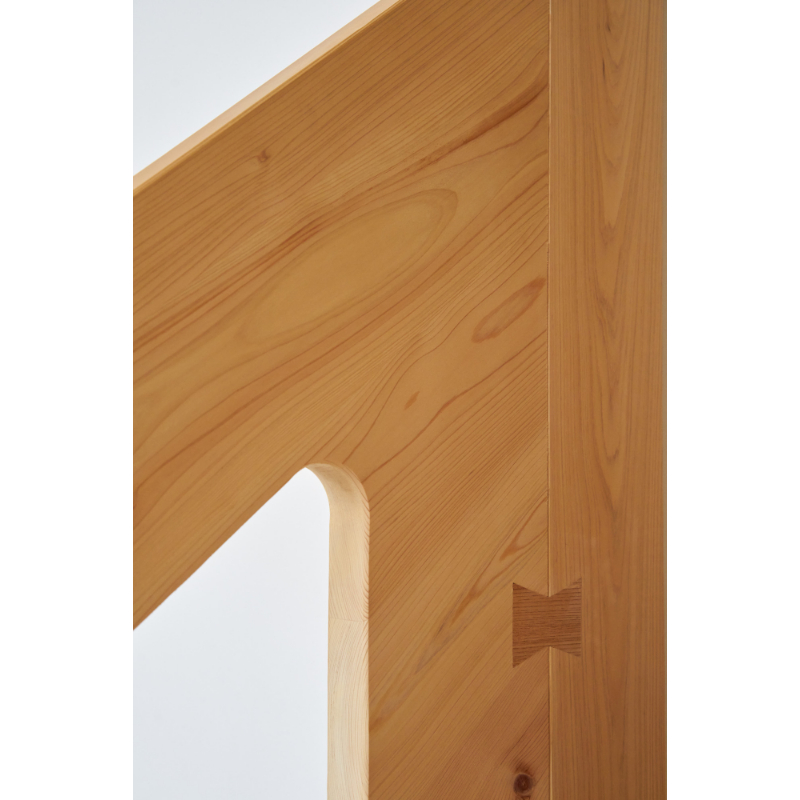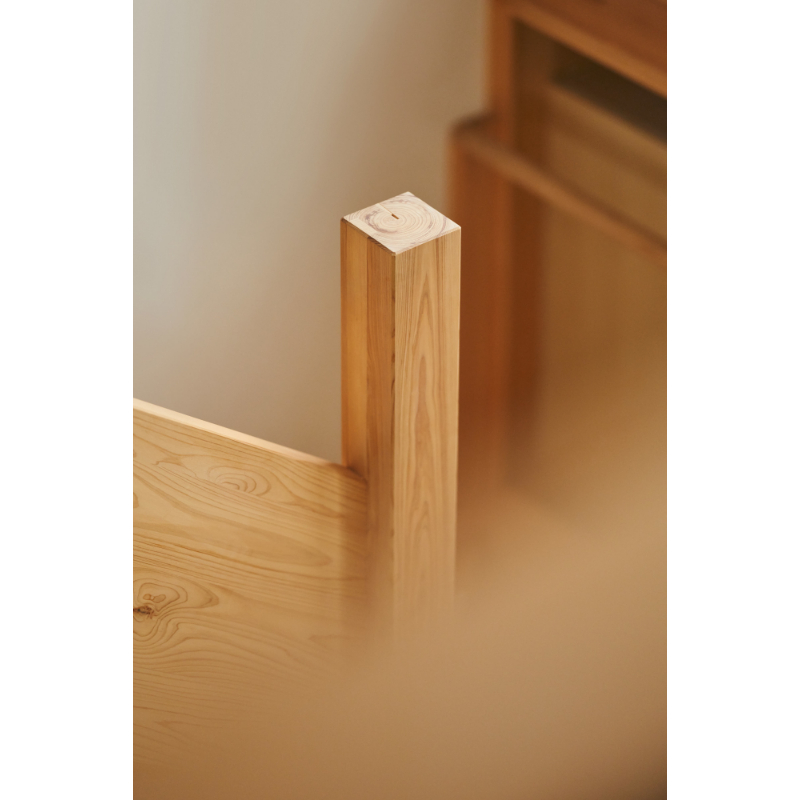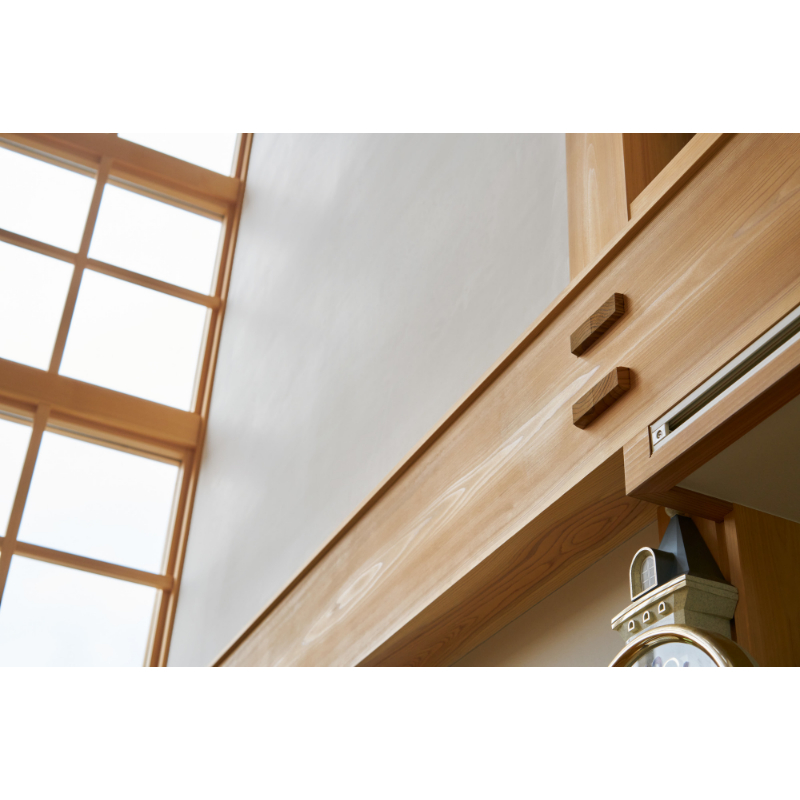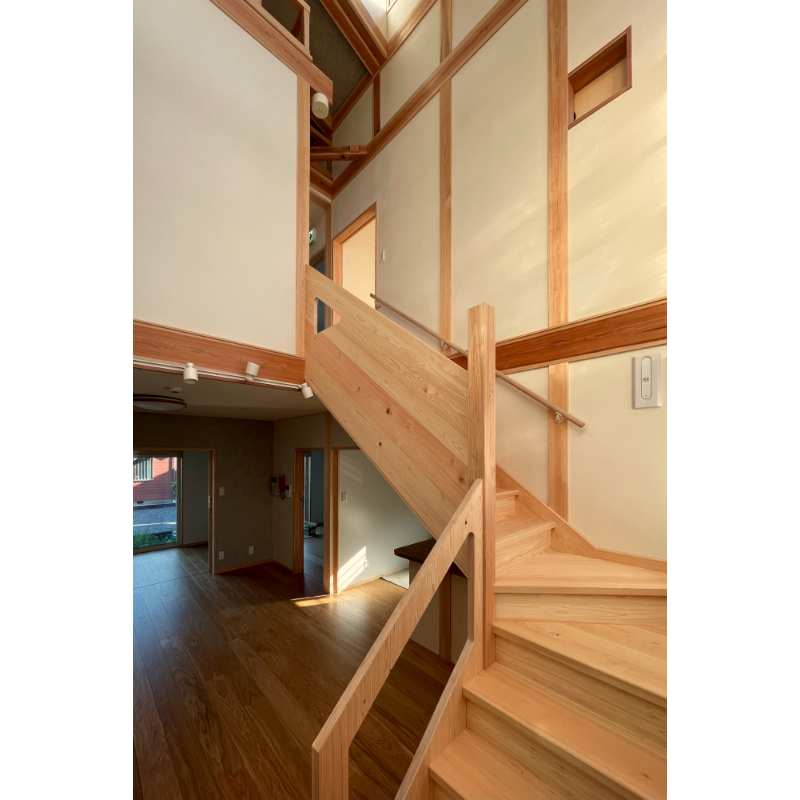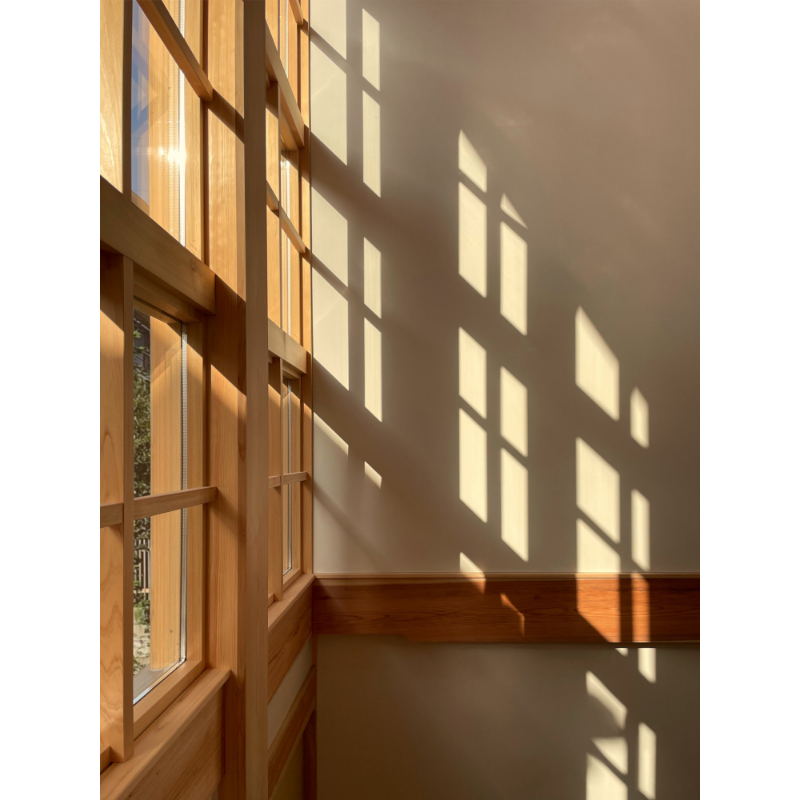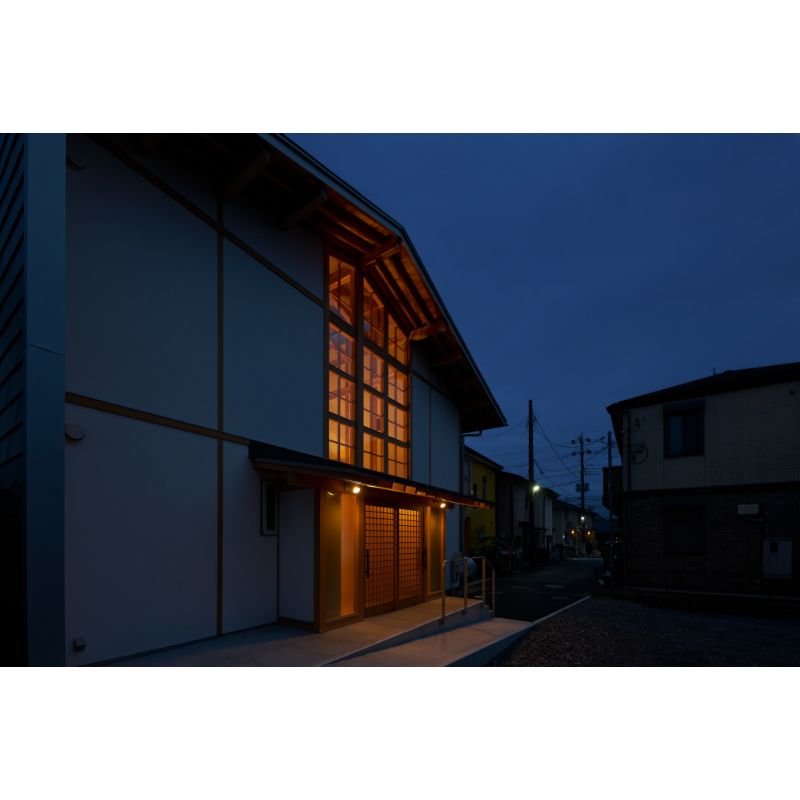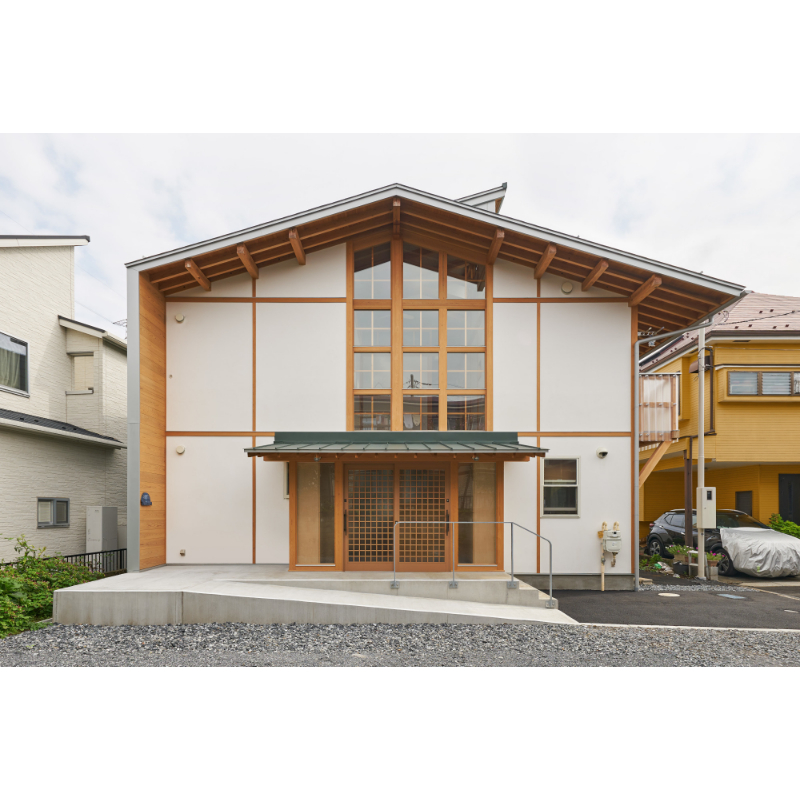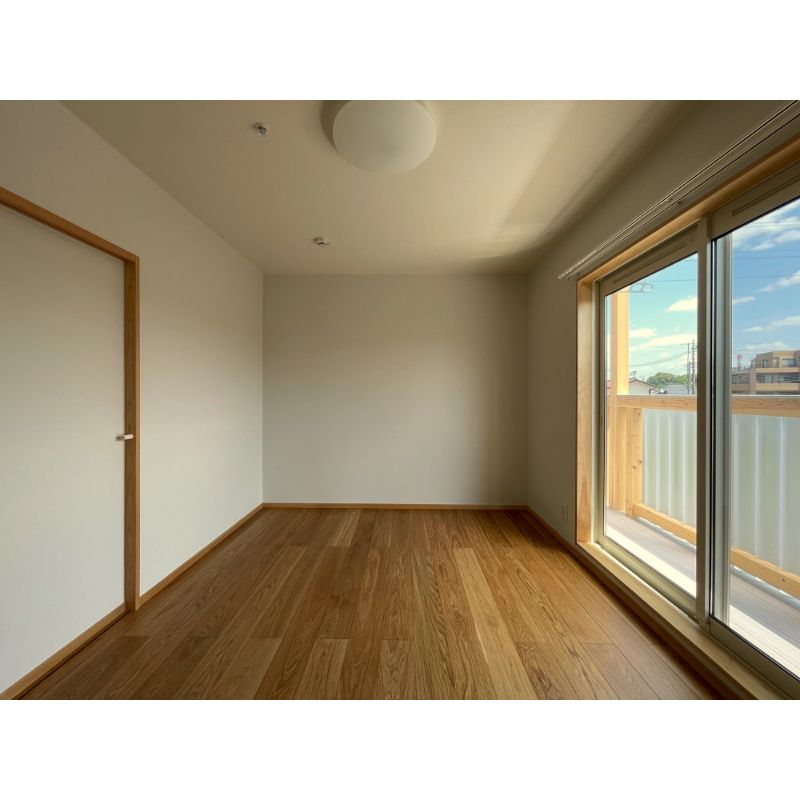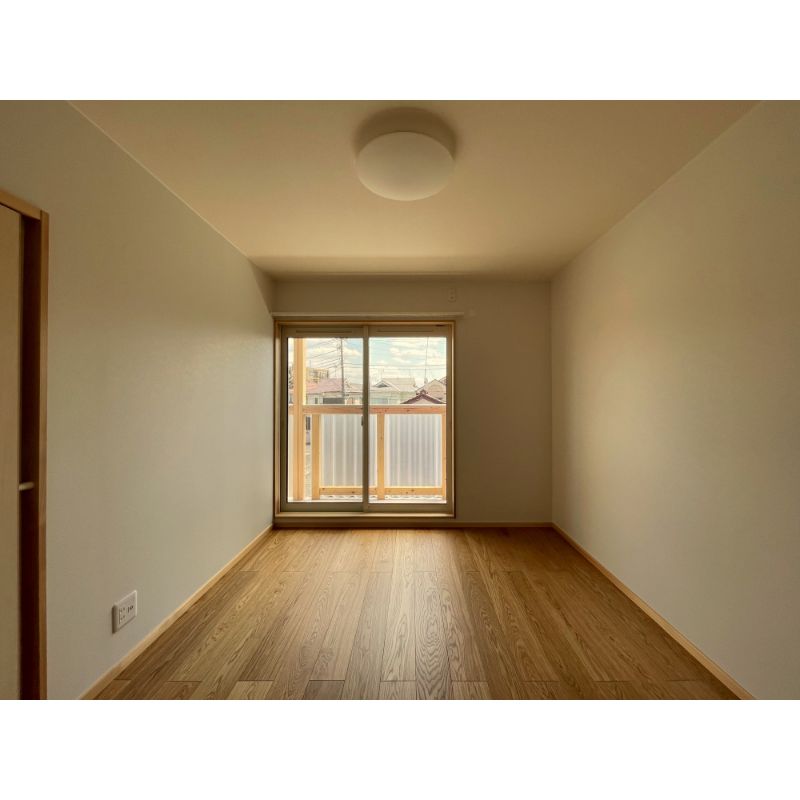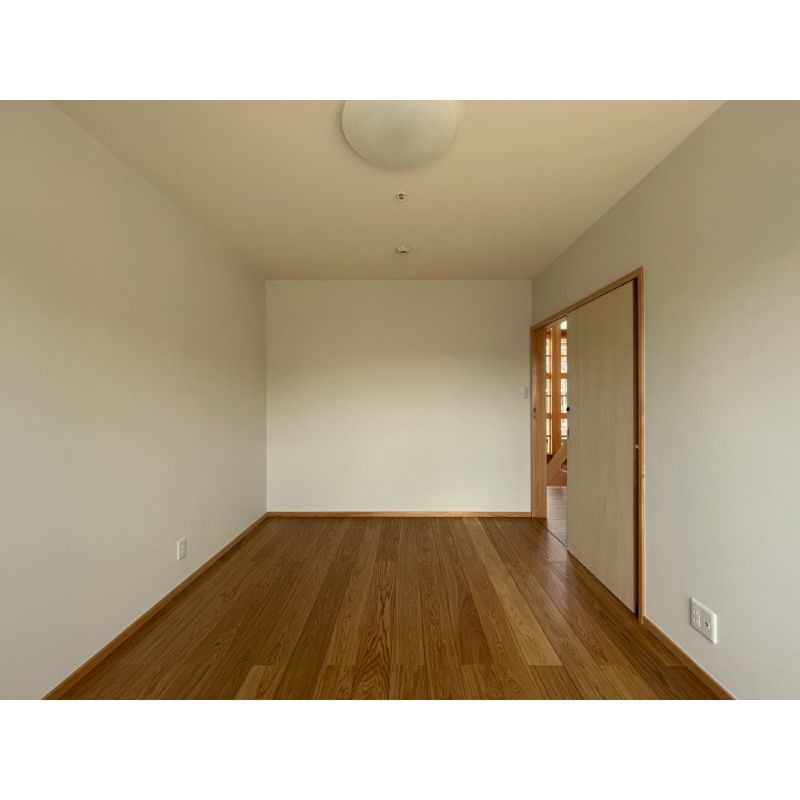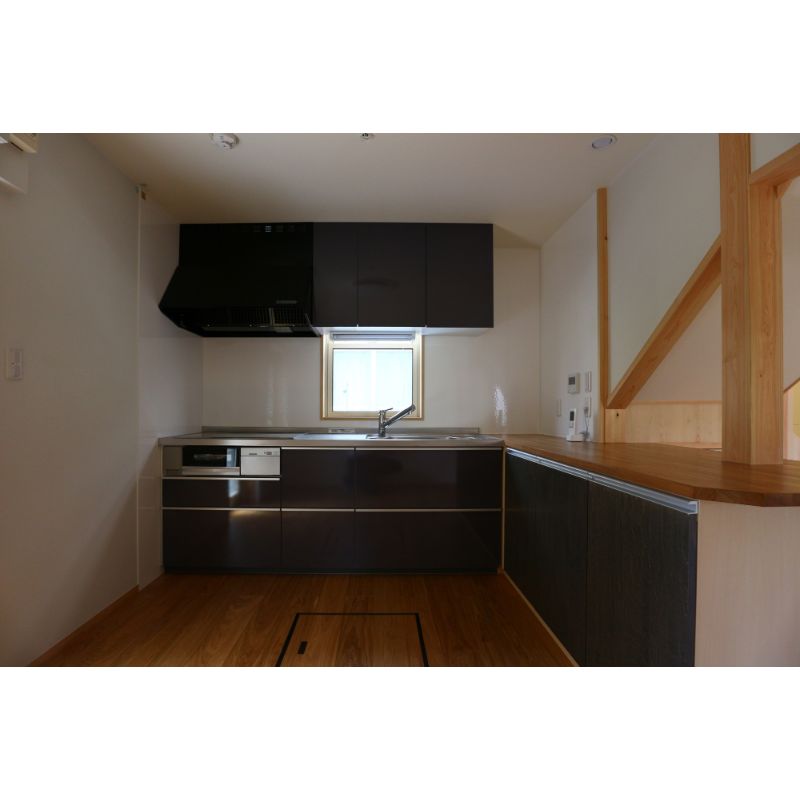グリーンハイツ(障害者グループホーム) / 2021
データ
所在地:東京都東村山市
敷地面積:275.49㎡
用 途:寄宿舎(グループホーム;6名)
階 数:地上2階・地下0階
高 さ:最高の高さ7.869m
構 造:在来木造
建築面積:84.16㎡
延床面積:134.13㎡
設計担当:土居志朗(統括)
施 工:作事庵
◼️障害者福祉制度の理念
多様性を認め合おうという社会的気運が近年高まっている。障害者福祉においても2011年施行の改正障害者基本法で『全ての国民が、障害の有無にかかわらず、等しく基本的人権を享有するかけがえのない個人として尊重されるものである』という理念の下、『相互に人格と個性を尊重し合いながら共生する社会を実現するため、障害者の自立及び社会参加の支援』を行うことが目指されている。
この法律を建築界から見て注目すべきは障害者の定義に身体、知的、精神における心身機能の障害のほかに「社会的障壁」が加えられたことである。この「社会的障壁」とは、『障害がある者にとって日常生活又は社会生活を営む上で障壁となるような社会における事物、制度、慣行、観念その他一切のもの』をいい、「事物」に関してはバリアフリー法による施設整備のルールの拡充で建築実務においても馴染みが深い。しかし、社会的障壁は段差や通路幅等の物理的障壁のことだけではなく、特に知的障害に関しては「制度、慣行、観念その他」における障壁が法改正から10年を経ても未だ大きく、建築もこれらの解消に如何に応えるかが課題である。
◼️長く暮らせる普通の家
これは定員6名の小規模な知的障害者グループホームの建て替えプロジェクトである。
施主からの「長く暮らせる普通の家」という要望は正に障害者福祉制度の理念を簡潔に表現したものと言えるが、それを建築の設計でどのように応えるかはなかなか難しい。施設ではなく戸建て住宅のようにしようという漠然としたことは当初から考えていたが、設計に際していくつか見学したグループホームはプレハブメーカーによるものや一般的な戸建て住宅を用途変更した良くも悪くも街に埋没したもので、表層的にこれらを「普通」と捉えることも出来る。しかし単にそうしたことではないことは、建物よりもそこの世話人の人柄がグループホームの現れに強く影響していることからも感じ取られた。
つまり、その小さな「家族」が地域社会、ご近所にどのように現れるかは、形や表層の問題以上に人びとの心の問題であり、建築は「情の緒」として、その背景や舞台として彼らに寄りそうべきではないかと考えた。
「障害者」という呼び方は、福祉制度の上では定義が必要なものだが、その境界は曖昧であるし、むしろ建物やまち、社会の方に障害(バリア)があると考えることもできる。例えば車椅子の人にとって床や通路の段差は障害なので段差を解消すれば改善される。しかし、知的障害という場合、そもそも法令上の定義が無く、物理的なバリアが存在する訳でもない。それは、本人と地域社会の心のバリアであり、そのバリアフリーは、本人の自尊心の持ち様と地域社会でのコミュニケーションのあり方が課題として挙げられるのではないか。
◼️チームによるプロジェクト
このグループホームの施主は個人で、社会福祉法人が賃借して運営している。既存棟の老朽化と防災設備の対応等で建て替えが求められながらも工事中の仮住まいの問題や資金計画、収支計画の不安が設計以前の課題としてあった。
そこで、同一敷地内での住まいながらの建て替えとその事業収支計画を提案し、収支計画どおりの工事費をマネジメントする為に信頼をおいている大工を設計当初から施工者に指名して、施主、運営者、施工者、設計者の4人5脚でプロジェクトを進めることにした。
作事庵の油布さんは飯能の若手の大工で数年前に設計した住宅で良い仕事をしてくれたことが声を掛けたきっかけであった。今回は場所も近く、木材も地元産の西川材を使ってくれることなど、地の利を活かすことで求めている「普通」に近づけるのではないかと考えて紹介したが、それ以上に彼の人柄を施主、運営者が気に入り、現場でも世話人、利用者、そしてご近所の人たちまでもが心を開き、難しい工事ながら円滑に進められ、ご近所との「普通の関係性」を良好に維持出来たことが指名して一番良かったと思えたことだ。既存棟に住まいながらの建替えだった為、利用者やご近所との交流が保たれ、私たちもその輪に入り、現場には「普通」を感じられる空間が生まれていた。
◼️グループホームの構成と仕様
このグループホームは施設っぽく見えないように利用者6名の個室と世話人室からなる7LDKの住宅として考え(確認申請での用途は寄宿舎)、鍵付き個室、吹き抜けのあるリビング、道に開かれた多目的な庭による「籠る、集う、交わる」の空間構成を取っている。
個室は吹き抜けを介してリビングに面することで各々の気配を感じられるようにし、個室の引戸には錠が付きプライバシーが守られ、籠ることができる。リビングは北に面する大きな窓と吹き抜けによって利用者が集まるのに適した気積と明るさを確保した。庭は既存棟解体後に砂利を敷いただけだが、位置指定道路の終端にある溜まりような場所性や、縁側的な造りの玄関、庭へサービスできるキッチンの上げ下げ窓、勝手口から軒下を介しての庭への動線によって内と外の繋がりを意識しており、ご近所さんとの交流などの今後の活用や展開に期待している。
他のホームでも収納が不足しがちとのことで、ロフトを含めて約6畳の収納スペースを分散して設け、各個室の収納は置き家具での対応とした。エレベーターはスペースと予算の都合で設置しなかったが、1階はバリアフリー仕様として高齢者は1階に入居してもらうという選択的対応を取った。
防災設備は、自火報設備(感知器及び火災通報装置)、非常用照明、誘導灯、消火器、スプリンクラー設備、漏電火災警報器を設置し安全・安心に備えている。
吹き抜けは換気用高窓で重力換気による涼風が流れ、冬季の冷気には木製サッシとLow-eペアガラスの断熱に加え、シーリングファンでの空気の攪拌で対応した。建物外皮は真壁に見えるが付け柱・付け梁で通気工法としており、断熱はUA値0.6W/㎡Kの省エネ仕様としている。
構造は在来木造とし、現しの軸組は大工の手刻みで加工された。壁量は基準の1.5倍以上確保し、部材寸法は一般的なものとしたが西川材はヤング係数が国産材平均より高いので実際には変形に対する安全性が高まっている。地産地消で西川材をふんだんに使ったことで構造の安全性に加え、木の温かみがこの家の特徴として現れている。
◼️住まいながらの建て替え
工事中の仮住まいの場所探しや引越しによる利用者の心身の負担を無くす為、同一敷地内で住まいながらの建て替えを行なった。南側の庭と駐車場にしていた限られたスペースに新築棟を計画したため、①空地部分に新築棟建設(玄関部分除く)、②新築棟へ引越し、③既存棟解体、④新築棟の玄関部分建設、⑤竣工、という手順で進めた。
新築棟への引越しの段階では、既存棟があるため建ぺい率、容積率の一時的な超過や新築棟の玄関部分の未完成などにより工事中の使用となる。玄関未完成による避難経路と主要な出入口の確保については勝手口で対応できるように配置してあり、集団規定のみ満たしていない(完了検査前なのであくまで工事中ということで違反ではない)状態に留め、建物としては安全であるよう計画した。また、4号建築物として仮使用認定手続きを不要(一級建築士による工事監理が条件)にした。消防設備の未完成については工事中の代替措置を講ずることで合格の検査結果通知書を得られた。これらによって東京都の障害福祉サービスの補助を切れ目なく受けることが出来た。
工事中の騒音や振動は解体工事で多少あったものの、住まいながらの建替えは、建て方や漆喰塗りなど職人の手仕事を間近に見ながら少しずつ自分の家が出来上がる様子を見届けられるという体験は利用者の皆さんにとってかけがえのないものになったに違いない。
◼️建築と情緒
数学者の岡潔は、数学も情緒であると言っている。というより『人間の中心は情緒である』と言っている。
『情は常に働いていて、知とか意とかはときに現れる現象だから、情あっての知や意です。「わかる」というのも、普通は「知的にわかる」という意味ですが、その基礎には、「情的にわかる」ということがあるのです。』
『心がわかり合うというときの「わかる」は、口ではいえないような、意識を通して見ることのできないような「わかる」です。知的な「わかる」ではなくて、情的な「わかる」です。』
「普通」の家を考える時、第一に誰もが情的にわかる家にしたいと思った。
1)触れる光
自然光は情に触れる重要な要素であり、情でわかる光は素材感、触感を伴う皮膚感覚に近いものである。
プランはプログラムや運営者の要望、敷地条件からほぼ自然に今の形が導かれたが、そこにどのような光を採り入れリビングに集まった人たちを包み込むかを建築的な主題とした。
居室を南側に配置したことでリビングは北側になったが階段室を兼ねた吹き抜けを持つ。この吹き抜けを白土漆喰の真壁で仕上げて自然光が明るく拡散するようにした。北面は大きな木製サッシで安定した天空光と空への眺望が得られ、西側の排煙と換気を兼ねた開口から午後の日射が差し込み漆喰壁やガラス窓の木製格子と大黒柱を照らす。1階の居住域には直射日光が届かないようにしているが、同じ仕上げの漆喰や木部に触れることが出来る。
2)情の緒としてのエレメント
芭蕉が『物に入りて』というように、情とは物と心とが無分節の状態のことを言う。表層的分節の「私意のなす作為」から情緒は現れない。岡潔は、情は懐かしさと喜びからなると言い、『花が咲くということは、花が咲くという心、つまり情緒が形となって現れること』だと言っている。
『物によりて思う心を明かす(物に託して思いを表す)』(「三冊子」土芳)
この建築では情の緒となりうるエレメントを散りばめた。西川材の現しの桧や杉とその肌理、真壁と貝灰入り本漆喰、垂木や小幅板を現しとした深い軒、無地で美しい杢目の桧の大黒柱、利用者らによる銅板彫金の館銘板、大工の手仕事跡として現れたほぞや込栓や契り、そして木製サッシから見える常に動いている空。
これらプロットされた情の緒が各々の心の中でひとまとまりの風景として像を結ぶこと、それが建築における情緒の現れである。
竣工後に運営者から「利用者は各自職場等で新しい家を自慢しているようです」との話を聞き、この家が「普通の暮らし」に寄り添えるものになったのではないかと感じている。
(土居志朗)
data
Green Heights (2021)
Program :Group home for people with intellectual disabilities(6 persons)
Client : Private
Location : Noguchi-cho, Higashimurayama-shi, Tokyo
Site area : 275.49 sq.m
Total floor area : 134.13 sq.m
Building height : 7.869m
Structure:wooden(2 stories)
Completion : 2021
Architects : Shiro Doi (Aida-Doi-Architects)
General Constructor :SAKUJIAN
This project is the rebuilding of a group home for people with intellectual disabilities.
The client's request for a ‘normal house where they can live for a long time’ is a simple expression of the philosophy of the welfare system for the disability: ‘All citizens, regardless of disability, should be respected as irreplaceable individuals with equal access to basic human rights.’
The term 'disability' needs to be defined in the context of the welfare system, but its boundary is blurred and it can be thought of as a barrier to buildings, towns and society. For example, for a person in a wheelchair, a step in the floor or in a corridor is a barrier, which can be improved by removing the step. However, in the case of people with intellectual disabilities, there is no legal definition in Japan, nor is there a physical barrier. I think it is a psychological barrier between them and their community, and the issue of barrier-free communication within the community and their self-esteem is a key issue.
Therefore, I wanted to create their house that is modest and fits in with the neighbourhood, but that the residents can be proud of.
The group home is conceived as a house with 6 bedrooms rather than a closed institution to fit in with the neighbourhood, and has a spatial structure of 'staying, gathering and communing' with lockable private rooms, a living room with a stairwell and a multi-purpose garden open to the street.
The bedrooms face the living room through a stairwell so that each can feel the presence of the other, and the sliding doors can be locked to ensure privacy and seclusion. The living room has a large wooden window to the north and a stairwell, which creates an enough light and airspace for people to gather.
The garden, which was only graveled after the demolition of the existing house, has a location, at the end of the road, a Engawa-like entrance, a raised window in the kitchen facing the garden, and a pathway from the kitchen door to the garden through the eaves, creating a sense of connection between inside and outside. I’m looking forward to the future use and development of the house, such as interaction with neighbours.
The Japanese mathematician Kiyoshi Oka said that mathematics is also an emotion(Joucho), or rather that the heart of human is an emotion.
He said:
"Emotion is always active, and intellect and volition are occasional phenomena, so that intellect and volition are based on emotion."
"The word 'understand' usually means to understand intellectually, but it is based on to understand emotionally."
In order to create a 'normal house', we wanted to create a house that everyone could understand emotionally.
1) Tactual light
Natural light is an important element that touches emotion, and light that can be understood emotionally is close to skin sensation with material and tactile feeling.
The plan of this project was derived almost naturally from the program, the requests and the conditions of the site, but the architectural theme was how to bring light into the living room and envelop the people gathered there.
The living room is located on the north side of the house, but it also has a stairwell. The stairwell is finished with Japanese traditional white plaster walls to allow natural light to diffuse through. On the north side, a large wooden window provides a stable skylight and a view to the sky, and on the west side, a smoke and ventilation opening allows afternoon sunlight to penetrate the stucco walls, the wooden lattices of the windows and the large wooden pillars.
2) The elements of emotion
As The haiku poet Basho said "Mono-ni irite" (Enter into things), emotion is the state in which things and mind are undivided. Emotion does not emerge from the intentional expressions. Oka Kiyoshi said that emotion consists of nostalgia and joy, and that "the blooming of a flower is the appearance of the emotion in the form of
a flower".
And Doho who is a disciple of Basho also said:
"Express one's thoughts by entrusting to the thing."
In this house, there are many elements that can be used as a symbol of emotion, such as Nishikawa's cypress and cedar wood(the local wood) and their texture, Japanese half timber walls and plaster with shell ashes, deep eaves with wooden rafters and small boards, plain and beautiful wooden cypress pillars, the nameplate of the house engraved with copper plate by the residents, the detail of craftmanship and the ever moving sky seen through the wooden window.
These plotted elements of emotions form a landscape in each person's mind, which is the expression of emotion in architecture.
After the completion of the work, the caretaker told me that "the residents seem to be proud of their new house at their workplaces", and I feel that this house has become a part of "normal life".
(Text by Shiro Doi)
